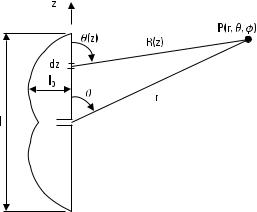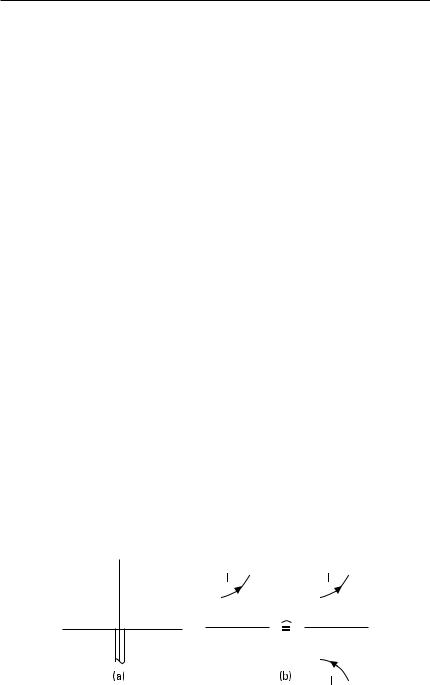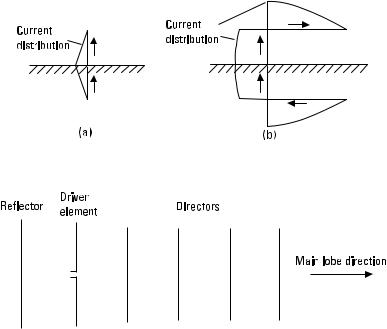
- •Radio Engineering for Wireless Communication and Sensor Applications
- •Contents
- •Preface
- •Acknowledgments
- •1 Introduction to Radio Waves and Radio Engineering
- •1.1 Radio Waves as a Part of the Electromagnetic Spectrum
- •1.2 What Is Radio Engineering?
- •1.3 Allocation of Radio Frequencies
- •1.4 History of Radio Engineering from Maxwell to the Present
- •2.2 Fields in Media
- •2.3 Boundary Conditions
- •2.4 Helmholtz Equation and Its Plane Wave Solution
- •2.5 Polarization of a Plane Wave
- •2.6 Reflection and Transmission at a Dielectric Interface
- •2.7 Energy and Power
- •3 Transmission Lines and Waveguides
- •3.1 Basic Equations for Transmission Lines and Waveguides
- •3.2 Transverse Electromagnetic Wave Modes
- •3.3 Transverse Electric and Transverse Magnetic Wave Modes
- •3.4 Rectangular Waveguide
- •3.4.1 TE Wave Modes in Rectangular Waveguide
- •3.4.2 TM Wave Modes in Rectangular Waveguide
- •3.5 Circular Waveguide
- •3.6 Optical Fiber
- •3.7 Coaxial Line
- •3.8 Microstrip Line
- •3.9 Wave and Signal Velocities
- •3.10 Transmission Line Model
- •4 Impedance Matching
- •4.1 Reflection from a Mismatched Load
- •4.2 Smith Chart
- •4.3 Matching Methods
- •4.3.1 Matching with Lumped Reactive Elements
- •4.3.4 Resistive Matching
- •5 Microwave Circuit Theory
- •5.1 Impedance and Admittance Matrices
- •5.2 Scattering Matrices
- •5.3 Signal Flow Graph, Transfer Function, and Gain
- •6.1 Power Dividers and Directional Couplers
- •6.1.1 Power Dividers
- •6.1.2 Coupling and Directivity of a Directional Coupler
- •6.1.3 Scattering Matrix of a Directional Coupler
- •6.1.4 Waveguide Directional Couplers
- •6.1.5 Microstrip Directional Couplers
- •6.2 Ferrite Devices
- •6.2.1 Properties of Ferrite Materials
- •6.2.2 Faraday Rotation
- •6.2.3 Isolators
- •6.2.4 Circulators
- •6.3 Other Passive Components and Devices
- •6.3.1 Terminations
- •6.3.2 Attenuators
- •6.3.3 Phase Shifters
- •6.3.4 Connectors and Adapters
- •7 Resonators and Filters
- •7.1 Resonators
- •7.1.1 Resonance Phenomenon
- •7.1.2 Quality Factor
- •7.1.3 Coupled Resonator
- •7.1.4 Transmission Line Section as a Resonator
- •7.1.5 Cavity Resonators
- •7.1.6 Dielectric Resonators
- •7.2 Filters
- •7.2.1 Insertion Loss Method
- •7.2.2 Design of Microwave Filters
- •7.2.3 Practical Microwave Filters
- •8 Circuits Based on Semiconductor Devices
- •8.1 From Electron Tubes to Semiconductor Devices
- •8.2 Important Semiconductor Devices
- •8.2.1 Diodes
- •8.2.2 Transistors
- •8.3 Oscillators
- •8.4 Amplifiers
- •8.4.2 Effect of Nonlinearities and Design of Power Amplifiers
- •8.4.3 Reflection Amplifiers
- •8.5.1 Mixers
- •8.5.2 Frequency Multipliers
- •8.6 Detectors
- •8.7 Monolithic Microwave Circuits
- •9 Antennas
- •9.1 Fundamental Concepts of Antennas
- •9.2 Calculation of Radiation from Antennas
- •9.3 Radiating Current Element
- •9.4 Dipole and Monopole Antennas
- •9.5 Other Wire Antennas
- •9.6 Radiation from Apertures
- •9.7 Horn Antennas
- •9.8 Reflector Antennas
- •9.9 Other Antennas
- •9.10 Antenna Arrays
- •9.11 Matching of Antennas
- •9.12 Link Between Two Antennas
- •10 Propagation of Radio Waves
- •10.1 Environment and Propagation Mechanisms
- •10.2 Tropospheric Attenuation
- •10.4 LOS Path
- •10.5 Reflection from Ground
- •10.6 Multipath Propagation in Cellular Mobile Radio Systems
- •10.7 Propagation Aided by Scattering: Scatter Link
- •10.8 Propagation via Ionosphere
- •11 Radio System
- •11.1 Transmitters and Receivers
- •11.2 Noise
- •11.2.1 Receiver Noise
- •11.2.2 Antenna Noise Temperature
- •11.3 Modulation and Demodulation of Signals
- •11.3.1 Analog Modulation
- •11.3.2 Digital Modulation
- •11.4 Radio Link Budget
- •12 Applications
- •12.1 Broadcasting
- •12.1.1 Broadcasting in Finland
- •12.1.2 Broadcasting Satellites
- •12.2 Radio Link Systems
- •12.2.1 Terrestrial Radio Links
- •12.2.2 Satellite Radio Links
- •12.3 Wireless Local Area Networks
- •12.4 Mobile Communication
- •12.5 Radionavigation
- •12.5.1 Hyperbolic Radionavigation Systems
- •12.5.2 Satellite Navigation Systems
- •12.5.3 Navigation Systems in Aviation
- •12.6 Radar
- •12.6.1 Pulse Radar
- •12.6.2 Doppler Radar
- •12.6.4 Surveillance and Tracking Radars
- •12.7 Remote Sensing
- •12.7.1 Radiometry
- •12.7.2 Total Power Radiometer and Dicke Radiometer
- •12.8 Radio Astronomy
- •12.8.1 Radio Telescopes and Receivers
- •12.8.2 Antenna Temperature of Radio Sources
- •12.8.3 Radio Sources in the Sky
- •12.9 Sensors for Industrial Applications
- •12.9.1 Transmission Sensors
- •12.9.2 Resonators
- •12.9.3 Reflection Sensors
- •12.9.4 Radar Sensors
- •12.9.5 Radiometer Sensors
- •12.9.6 Imaging Sensors
- •12.10 Power Applications
- •12.11 Medical Applications
- •12.11.1 Thermography
- •12.11.2 Diathermy
- •12.11.3 Hyperthermia
- •12.12 Electronic Warfare
- •List of Acronyms
- •About the Authors
- •Index

Antennas |
217 |
9.4 Dipole and Monopole Antennas
Wire antennas are popular at frequencies below 1 GHz. The dipole antenna is the most often used wire antenna. It is a straight wire, which is usually split in the middle so that it can be fed by a transmission line.
It can be thought that a dipole shown in Figure 9.7 consists of current elements in a line. The far field is calculated by summing the fields produced by the current elements, that is, by integrating (9.20):
|
|
l /2 |
I (z ) e −jkR (z ) |
|
|
Eu = |
jvm |
E |
|
||
|
|
sin u(z ) dz |
(9.24) |
||
4p |
R (z ) |
||||
−l /2
where l is the length of the dipole. It can be assumed that the current distribution I (z ) is sinusoidal and at the ends of the wire the current is zero. This assumption applies well for a thin wire. The current distribution can be considered to be a standing wave pattern, which is produced as the current wave reflects from the end of the wire. The current distribution is
I (z ) = |
I0 |
sin [k (l /2 − z )], |
for z > 0 |
HI0 |
sin [k (l /2 + z )], |
(9.25) |
|
|
for z < 0 |
where I 0 is the maximum P (r , u, f) it applies u (z )
current. Far away from the antenna at a point ≈ u and 1/R (z ) ≈ 1/r , so these terms can be
Figure 9.7 Dipole antenna.

218 Radio Engineering for Wireless Communication and Sensor Applications
assumed to be constant in (9.24). However, small changes in R (z ) as a function of z have to be taken into account in the phase term e −jkR (z ). The distance from P to the element is
R (z ) = √ |
|
≈ r − z cos u |
|
r 2 + z 2 − 2rz cos u |
(9.26) |
From (9.24), the field radiated by the dipole is
|
|
|
|
cos S |
1 |
kl cos uD − cos S |
1 |
kl D |
|
||
Eu = |
jhI0 |
e |
−jkr |
2 |
2 |
(9.27) |
|||||
2pr |
|
|
|
|
sin u |
|
|||||
|
|
|
|
|
|
||||||
If the dipole is short compared to a wavelength, the current distribution is approximately triangular. Its radiation resistance is a quarter of that of the Hertz dipole having the same length:
|
|
|
|
|
|
Sl D |
|
|
|
|||
|
R r ≈ 20p 2 |
|
l 2 |
V |
(9.28) |
|||||||
|
|
|
|
|
||||||||
This is valid up to about a length of l |
= l/4. |
|
||||||||||
The half-wave dipole is the most important of dipole antennas. When |
||||||||||||
l = l/2, it follows from (9.27) that |
|
|
|
|
|
|
|
|
||||
|
|
|
|
cos S |
p |
cos uD |
|
|||||
Eu = |
jhI0 |
e |
−jkr |
2 |
(9.29) |
|||||||
2pr |
|
|
|
|
|
sin u |
|
|||||
|
|
|
|
|
|
|
||||||
The maximum of the field is in the plane perpendicular to the wire and the nulls are along the direction of the wire. The half-power beamwidth is u3dB = 78°. The directivity is D = 1.64 (2.15 dB), which is also the gain G for a lossless half-wave dipole. The directional patterns of the half-wave dipole and the Hertz dipole (u3dB = 90°, D = 1.5) are compared in Figure 9.8. The radiation resistance of the half-wave dipole is R r = 73.1V in a lossless case. The input impedance also includes some inductive reactance. The impedance could be made purely resistive by reducing the length of the wire by a few percent; this will reduce the radiation resistance too. In practice, the properties of the half-wave dipole also depend on the thickness of the wire.

Antennas |
219 |
Figure 9.8 Normalized directional patterns of the half-wave and Hertz dipole.
Figure 9.9 shows a folded dipole. Both of the half-wave-long wires have a similar current distribution. Therefore, the folded dipole produces a field twice of that of the half-wave dipole for a given feed current. Thus, the radiated power is four times that of the half-wave dipole and the radiation resistance is about 300V. A parallel-wire line having a characteristic impedance of 300V is suitable for feeding a folded dipole antenna.
If a dipole antenna has a length of a few half-wavelengths, its directional pattern has several lobes. Figure 9.10 shows the current distribution and directional pattern of a 3l/2-long dipole. As the length l further increases,
Figure 9.9 Folded dipole antenna.
Figure 9.10 A 3l /2-long dipole antenna: current distribution and directional pattern.

220 Radio Engineering for Wireless Communication and Sensor Applications
the number of lobes increases. The envelope of the lobes forms a cylinder around the z -axis. The feed point of a dipole antenna is usually in the middle but can be at some other point. The directional pattern and impedance depend on the position of the feed point.
Example 9.2
Let us consider two dipole antennas having lengths of 0.1l and 0.5l . Both have a feed current of 1A. What are the radiated powers?
Solution
From (9.28), the radiation resistance is R r = 1.97V as l = 0.1l. The radiated power P = 1⁄2 R r I 2 = 1.0W. For the half-wave dipole, R r = 73.1V and P = 36.5W. Thus, a short dipole is ineffective and its small resistance is difficult to match to a transmission line.
The monopole antenna is a straight wire above a ground plane as shown in Figure 9.11(a). In the analysis, the image principle can be applied. The conducting plane can be removed if an image of the current distribution is placed on the other side of the plane, as in Figure 9.11(b). This way the tangential electric field vanishes at the plane where the conducting plane was.
The monopole antenna and the dipole antenna formed according to the image principle have similar fields in the half-space above the ground plane. For a given feed current, the power radiated by the monopole is half of that of the corresponding dipole because the monopole produces no fields below the ground plane. Therefore, the radiation resistance of a quarterwave monopole is 36.5V, which is half of that of a half-wave dipole. The gain of the monopole is twice of that of the dipole.
In practice, the ground plane of a monopole antenna is finite and has a finite conductivity. Therefore, the main lobe is tilted upward and there
Figure 9.11 (a) Monopole antenna; and (b) image principle.

Antennas |
221 |
may be a null along the direction of the surface. At low frequencies, a flat ground acts as a ground plane. The conductivity may be improved by introducing metal wires into the ground.
Monopole antennas operating at VLF and LF ranges are short compared to a wavelength and have a low radiation resistance. Their efficiency can be improved by adding a horizontal wire at the top, as shown in Figure 9.12. Due to the top loading, the current in the vertical part is increased. The fields produced by the vertical part and its image add constructively. However, the fields from the horizontal part and its image cancel each other, because their currents flow to opposite directions and their distance is small compared to a wavelength.
Dipole and monopole antennas are omnidirectional in the plane perpendicular to the wire and thus have a low directivity. Figure 9.13 shows a Yagi (or Yagi-Uda) antenna, which is an antenna commonly used for TV reception. It consists of an array of parallel dipoles, which together form a directional antenna. Only one element, the driven element, is fed from the transmission line. There is a reflector behind the driven element and directors in front of it. Currents are induced to these parasitic elements. The fields
Figure 9.12 (a) Short monopole antenna; and (b) top-loaded monopole antenna.
Figure 9.13 Yagi antenna.
